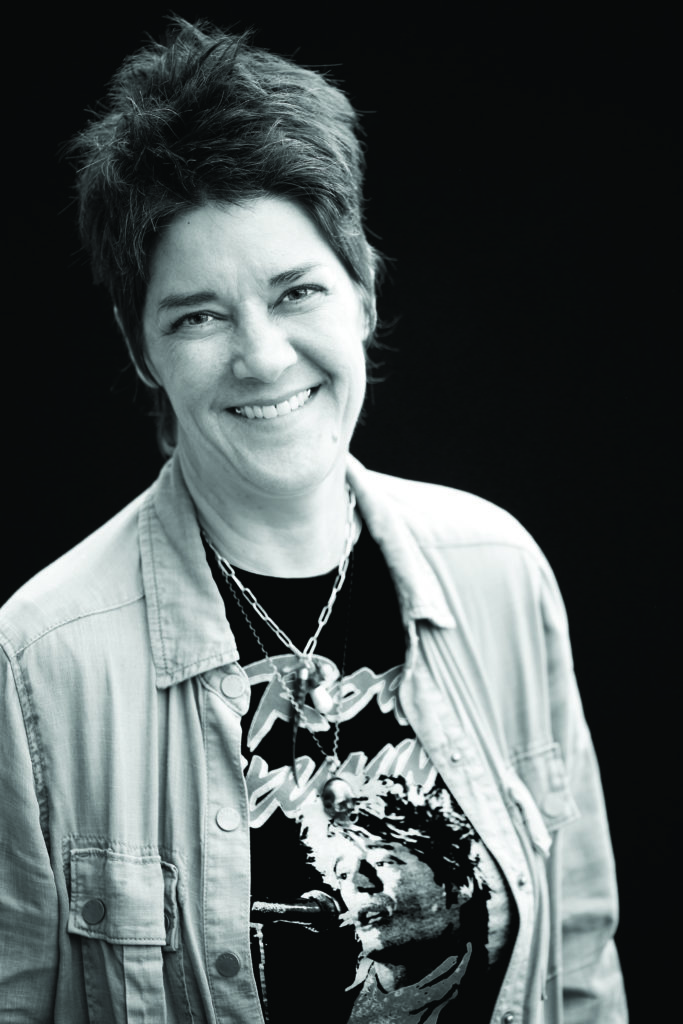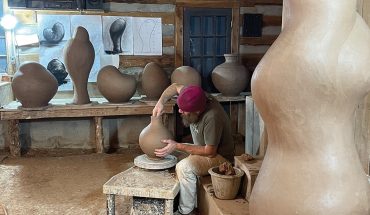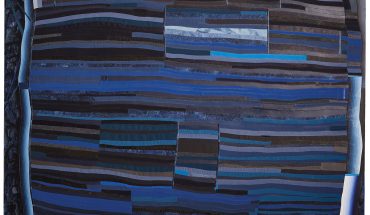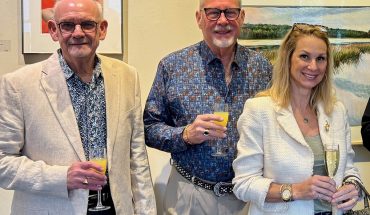The Spruce Pine artist studies wildlife closely, then covers her intricate replicas in skin created from vintage art.
by Liza Roberts | portrait by Lissa Gotwals
If you’ve seen any of Anne Lemanski’s cosmic, colorful animal sculptures in person, you know they look as if they might twitch, or pounce, or slink on by. The skins that cover them, psychedelic prints and unexpected patterns, somehow add to this unlikely effect. Perhaps her multihued tiger, or her fierce ocelot, or her amazing rabbit, has emerged through a looking-glass portal from some magical realm and wound up in our own?
You’re not far off. Lemanski’s Spruce Pine studio is an otherworldly laboratory of creation where she doesn’t just make an animal, she learns it inside out. She studies its physicality and psychology, figures out how its haunches tense when it sits back, how they loosen in a run, how its brow might scowl at distant prey. Then she replicates all of that with copper rods she bends, cuts, and welds into a three-dimensional sculpture, an armature. In an upstairs studio made of shipping containers, another act of creation happens, guided not by realism but by intuition. Here, she will create a skin for that armature out of digital photographs or prints or collage or all three, and print it on paper. She will draw and cut a pattern as if she were making a dress or a suit, and sew it all on, piece by piece, with artificial sinew. Her tools — wire cutters and an X-Acto knife — are the same, simple ones she has used for thirty years. She has no assistants.
On a warm spring weekend, Lemanski is learning mink. Her giant mastiff, Dill, sits nearby. Photographs of mink in every position and resolution surround her, filling a wall and every tab on her computer. She’s learning about what mink eat, how they’re bred for coats, about the recent killing of 17 million Covid-infected mink in Denmark. “Millions! I’m not exaggerating. I was horrified,” she says, shivering. The armatures for a few mink in different positions are underway; one is complete. She holds it in her hands. “The armature is the most important part of capturing the animal,” she says. “I ripped this apart three times; finally, it just clicked.”
With the armature complete, Lemanski moves on to the mink’s skin, leaning into the collages that form a significant counterpart to her sculpture. Comprised of illustrated images from the pages of pre-1970s textbooks, comic books, picture books, and encyclopedias, Lemanski uses her X-Acto knife to combine, say, giant squid with convertible cars, pigeons with mermaids, chewing gum with polar bears. There are butcher’s maps for cuts of meat and colored-dot tests for colorblindness, and constellations and cockatoos — a century’s worth of illustrations shaken and stirred into a cocktail of nature and man, science and myth, technology, geometry, and things that are cool. A series made during Covid, Metaphysical Mineral, explores the properties of a series of eight different minerals. “Quartz”includes a high diver in a 50s-era swimsuit, a white stallion, and a swarm of bees. “Sulphur” gets a winding snake, a stick of dynamite, and a cigarette.
These individual component images are one of a kind and cannot be replicated; to do so would be to lose the unmistakable texture and character of the Ben Day dots used in printing from the 1950s to the 1970s (made particularly recognizable by the pop artist Roy Lichtenstein). “I’ve tried [copying them] and it just doesn’t work,” she says. So when she uses these images in a collage, Lemanski tacks them down lightly with a little loop of tape so she can take them off and use them again. This technique also adds to the three-dimensional look of the collages once they’re printed.
She credits a residency at Charlotte’s McColl Center with launching this kind of work. Inspired by the possibilities of the Center’s large-format digital printer, she made 12 small collages and printed them in huge dimensions. These prints ended up forming the basis of a solo exhibition that also included sculpture, in this instance a “three-dimensional collage” that incorporated some of the printed collage animals themselves. A 4-inch image of an impala in one print, for instance, became a life-sized impala sculpture in the center of the room that she “skinned,” in a meta twist, in digital prints of the tiny image’s own fur.
So was the Tigris T-1, a freestanding, life-size sculpture of a tiger balancing on a ball that was acquired by collector Fleur Bresler for donation to Crystal Bridges Museum, a career-catapulting moment Lemanski is still pinching herself about. Her work is also in the permanent collections of the Mint, the North Carolina Museum of Art, the Asheville Art Museum, and many private collections. It’s even found its way into wallpaper as part of a line of sly, butterfly-and-bird-bedecked prints made in Schumacher’s Peg Norriss collection, a collaboration between Charlotte gallerist Chandra Johnson and interior designer Barrie Benson.
What’s next excites Lemanski most. Lately, she’s been working on an animal that’s captured her imagination for a while: a horse, a life-sized Appaloosa. “Who doesn’t love a horse?” she asks, as she works out the intricacies. “The hooves and ankles of a horse are extremely complex; they’re bulbous, they’re angular, and that’s where all the business happens.” Also in the hopper: her first piece of public, outdoor art, another large animal, to be cast in aluminum. It could mark the beginning of a whole new oeuvre.
“I’m looking forward to the work I’m going to make in the future,” Lemanski says. “I think it’s going to be on a large scale, and I just want to keep pushing it forward… It’s the unknown of the future that keeps me going.”
_______
This is an excerpt from the forthcoming book Art of the State: Celebrating the Art of North Carolina, to be published by UNC Press this fall. It originally appeared in the April 2022 issue of WALTER Magazine.




